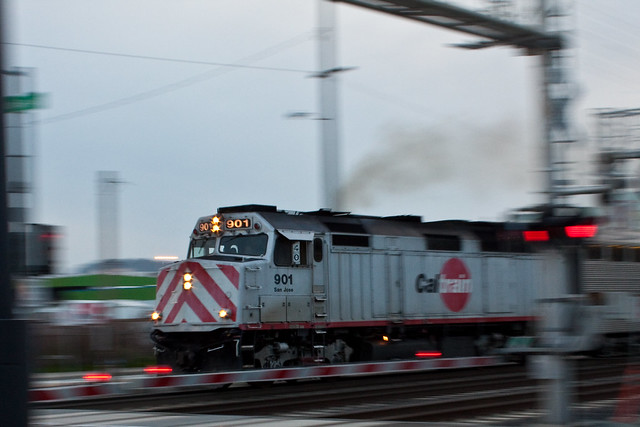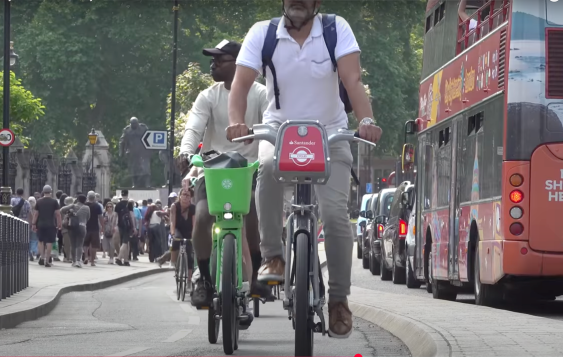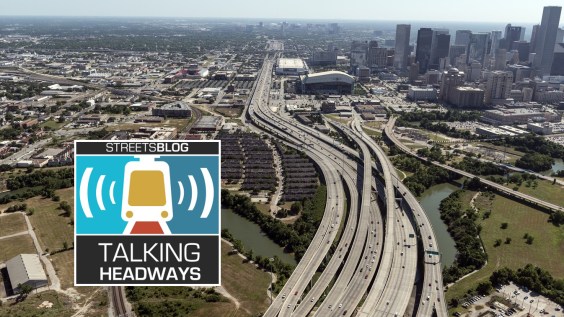
The mobility of Caltrain's 40,000 daily riders on the Peninsula and the South Bay could drastically suffer under deep service cuts being considered to close a $30 million budget gap, but a movement to get the commuter rail service agency out of the red and on a path toward long-term sustainability is gaining momentum.
"Everyone says it's ironic, because it really is one of the best performing transit agencies in the whole Bay Area, but it's the one potentially in the most trouble because we lack any dedicated funding," said Yoriko Kishimoto, a Palo Alto councilmember and Friends of Caltrain organizer.
Last Friday, a summit brought together a number of transportation officials, advocates, neighborhood groups, riders and public officials hoping to rescue Caltrain. This Saturday, Friends of Caltrain, a "grassroots coalition of cities, neighborhood groups, employers, environmental groups, transit advocates and, most importantly, residents and transit riders" in the Bay Area, are helping to organize the "Save Our Caltrain!" Summit to address the agency’s lack of dedicated regional funding.
“Caltrain is threatened with bankruptcy, or just as bad, it could die a slow death by entering a downward spiral of reduced service and reduced ridership,” said Kishimoto. “Caltrain ridership is the equivalent of at least three full lanes of traffic on US 101…[It] is essential to the Peninsula’s quality of life, our commute alternatives, and economic vitality and the three counties must come together to work on solutions.”
The system relies heavily on support from the Metropolitan Transportation Commision and transit agencies in San Francisco, San Mateo and Santa Clara Counties to help cover its costs each year. However, with California transit agencies struggling across the board, those contributions have been slashed.
Without further help from regional elected officials, Caltrain is looking at "18 months of pretty devastating cuts," said Kishimoto.
Caltrain Board Chair and San Francisco Supervisor Sean Elsbernd told the Mercury News that service could be curtailed to minimum peak hours, with weekday trains reduced from 86 to 48 along with the elimination of weekend trains and all service between Gilroy and San Jose Diridon Station.
Those service cuts will likely impose a hardship on the many commuters, businesses, and institutions who depend heavily upon Caltrain for transportation, and Friends of Caltrain is "looking to create a political movement across the three counties to protect the regional transit that links them," said Kishimoto.
Aside from looking at ways to help Caltrain stave off immediate cuts, the group is eyeing long-term revenue sources. High-speed rail funds, for example, could become one light at the end of the tunnel.
Despite political difficulties in the past, Kishimoto hopes "the time has come" to raise the gas tax. She thinks a Bay Area-wide one-cent increase approved by voters in November 2012 would be the most realistic option to substantially bolster Caltrain's reliable revenue. The 1.3 billion gallons of gas sold every year in the three counties served by Caltrain alone would bring in $13 million, almost half of the current deficit, she said.
Additionally, a tri-county payroll tax of just $20 per year could bring in $35 million, well over this year's entire deficit, according to Kishimoto. She also thinks congestion pricing and high-occupancy toll lanes are "seriously worth considering." They would relieve congestion on the 101 freeway, increase Caltrain ridership, and provide drivers the option of paying a premium for a predictable commute, which she said is what most people are really interested in.
But pricing on the 101 freeway alone could have the undesirable effect of "bumping" motor traffic onto local streets, and Kishimoto sees a Vehicle Miles Traveled tax "for wherever you're travelling" as the ideal long-term solution.
Reduced reliability on Caltrain could potentially create a surge in driving and freeway congestion on the Peninsula as well as put a serious dent in the wallets of corridor residents who, according to TransForm Executive Director Stuart Cohen, own 0.7 fewer vehicles, emit 42 percent less greenhouse gases, and spend $550 less per year on transportation compared to the Bay Area average.
Stanford University student Tiffany Lau is able to travel independently without a car by depending on Caltrain. "[It]’s one of the best alternatives for getting around the Bay Area," she said in a Friends of Caltrain press release. "It’s pretty easy to get from city to city." In 2010, Stanford University reportedly relied on the trains to transport 19 percent of its employees.
UC Berkeley Professor of City and Regional Planning Elizabeth Deakin also pointed out the economic benefits of the compact, transit-oriented development that Caltrain encourages around its stations as well as the environmental and health benefits it provides.
"The idea that we would let a tremendous asset go to waste is a foolish mistake...the benefits certainly outweigh the costs," she was quoted as saying in the Patch.
Given the immediate need to reduce driving to curb climate change and oil dependency, Kishimoto says Friends of Caltrain hopes "that we can turn this potential disaster into a transformation."
"Save Our Caltrain!" Summit
Speakers at this weekend’s summit will include Executive Director of the Sierra Club Michael Brune, San Francisco Supervisor and Caltrain Joint Powers Board of Directors Chair Sean Elsbernd, as well as Congresswomen Anna Eshoo and Jackie Speier.
"Speakers and panels in the morning will tell the Caltrain story and explore a range of options. The afternoon will be devoted to workshops to solicit the public’s innovative ideas on supporting Caltrain at this time of general fiscal crisis."
When: Saturday, January 29, 2011, 8:30 am to 2:30 pm.
Where: SamTrans Auditorium, 1250 San Carlos Avenue, San Carlos (near Caltrain).
Sign up: FriendsofCaltrain.com





